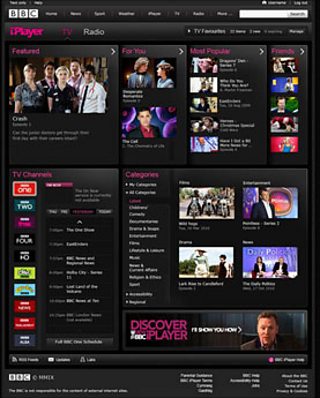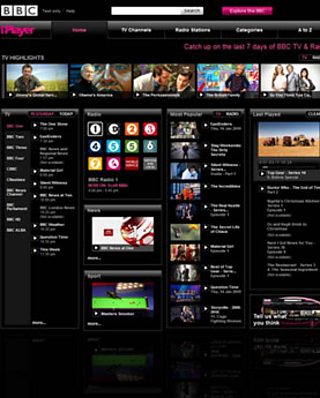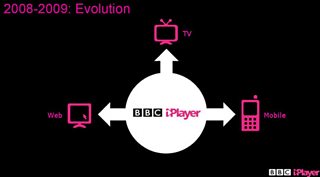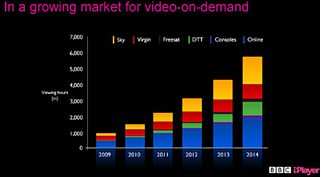
The idea for Βι¶ΉΤΌΕΔ iPlayer was first floated internally around seven years ago, when the web was in its relative infancy. The potential of on-demand was obvious, even if the networks, technologies and market wasn't there yet
But the potential public value of being able to offer our audiences more control (a digital VCR that you don't have to set) and the offer of better value for money (by providing more opportunities to access programmes they've missed) was huge. Some years later, on Christmas Eve 2007, the first-generation product launched.
That moment represented a turning point for the Βι¶ΉΤΌΕΔ, and for me personally, the most significant development to Βι¶ΉΤΌΕΔ Online since its launch in the late 1990s. In just two and half years Βι¶ΉΤΌΕΔ iPlayer has evolved to become one of our most popular websites, integral to Βι¶ΉΤΌΕΔ Online, and available on a very wide range of internet-connected devices.
The Βι¶ΉΤΌΕΔ wasn't the first mainstream media company to offer a video-on-demand service, but I do think we were the first to get it right. Some important early decisions contributed greatly to its appeal with audiences.

Second, it had an unrivalled content offer - no user-generated videos of cats on skateboards here. It was always distinctly Βι¶ΉΤΌΕΔ, understood to be the only place for Βι¶ΉΤΌΕΔ long-form content, and by extension a byword for quality. As good as we make the iPlayer experience; we never forget that it's the content, above and beyond the delivery, that brings people back.
Third, the proposition was made really clear to mainstream linear TV audiences. It was this clear communication of the simple proposition of "making the unmissable, unmissable" combined with integrated linear promotion, that helped video-on-demand cross over into the mainstream. And finally, we wanted to make the Βι¶ΉΤΌΕΔ iPlayer available on a platform neutral basis. The ability to repurpose the site for a wide range of internet-connected devices and platforms has enabled us to take the product to our audiences rather than prescribe that they access it on the PC alone.
But back in 2007, none of us were really sure about how successful the Βι¶ΉΤΌΕΔ iPlayer would be. Some people had doubts about take-up. Will people go for it? Do people really want to watch TV on their computers when they have a perfectly good TV for that, with dozens of channels already? Others expected a TV revolution. "It's the end of TV as we know it" - the idea that giving the power of control to audiences would wipe out linear TV and the "old fashioned" idea of scheduling.
The truth lies somewhere in the middle: we've been hugely encouraged by the reception of iPlayer, and while people clearly love greater choice, they're not ready to abandon live TV. Our schedulers are brilliant at picking the right programme for the right channel at the right time: and nothing beats the collective experience of live TV around big events, whether it's a dramatic climax in the live episode of Eastenders or the FA Cup Final..
The facts are these, only 0.4% of UK adults watch exclusively on-demand. Linear TV is going from strength-to-strength, UK research company Thinkbox revealed earlier this month that year-on-year, average viewing is up to some 30 hours a week - an increase of two and a half hours on the year before. On-demand viewing is clearly complementary.


Βι¶ΉΤΌΕΔ iPlayer has become recognised domestically and internationally as best in class, a pioneer in the field and a major stimulant in the overall market for on-demand services.
We've seen impressive growth in programme requests Βι¶ΉΤΌΕΔ iPlayer, and as the projections below (Mediatique, 2009) for video on demand show - this is a growing area across the entire media industry.

How does the Βι¶ΉΤΌΕΔ iPlayer fit in to this world and remain distinctive?
As I outlined at the Guardian's Changing Media Summit in March, just after we announced our , Βι¶ΉΤΌΕΔ Online is changing.
By halving the number of top-level domains on Βι¶ΉΤΌΕΔ Online, reducing the overall service-licence budget by 25% by 2012, focusing on the Βι¶ΉΤΌΕΔ's core editorial priorities, and developing strategic online partnerships we intend to put the internet at the heart of the Βι¶ΉΤΌΕΔ's digital media strategy, creating a more focused Βι¶ΉΤΌΕΔ Online with clear boundaries. The proposals outlined in the Βι¶ΉΤΌΕΔ's Strategy Review are subject to public consultation by the Βι¶ΉΤΌΕΔ Trust.
Βι¶ΉΤΌΕΔ iPlayer is a core component of Βι¶ΉΤΌΕΔ Online, and is the first core website in the online portfolio to be upgraded since we announced Putting Quality First.
Bringing the benefits of emerging technologies to the public is in the Βι¶ΉΤΌΕΔ's DNA as its sixth public purpose, and the idea behind Βι¶ΉΤΌΕΔ iPlayer was to give audiences greater control over the programmes they enjoy, guarantee subscription-free access to Βι¶ΉΤΌΕΔ content in an on-demand world, and provide better value for the content they have already paid for.
In the new beta version of the product we've launched today, we've listened to the audience and responded to their desire to have greater control over their own Βι¶ΉΤΌΕΔ iPlayer experience: now you can have a Βι¶ΉΤΌΕΔ built just for you.
We've integrated the social web through innovative partnerships, which allow audiences to interact with each other around our content. And we've pulled all this functionality together in a clean and intuitive user experience.
I can't emphasise the importance of good design enough. In age of unlimited choice - our audiences need better ways to find what they are looking for, and it is this thinking that we've brought into Βι¶ΉΤΌΕΔ iPlayer. In addition to discovery through traditional TV listings, you can now also:
- select your favourites, delivered to you in a playlist
- see what your friends are recommending
- browse by popularity, like a top-ten programmes chart
- browse by genre and sub-genre, depending on your mood
- try what we think you'll like, based on what you tell us
Along the way you'll be able to select your favourites, to be delivered to you when they're ready.
And later in the year, we'll be linking to other video on demand providers, and launching a new feature that will allow you to chat to friends.
There's a lot more information about the functionality and technology on the Βι¶ΉΤΌΕΔ Internet Blog if you're interested and you can find the .
So we very much hope that you like the new product, and if you'd like to be involved in the beta testing we'd love to hear from you.
is Director, Βι¶ΉΤΌΕΔ Future Media & Technology
- Read